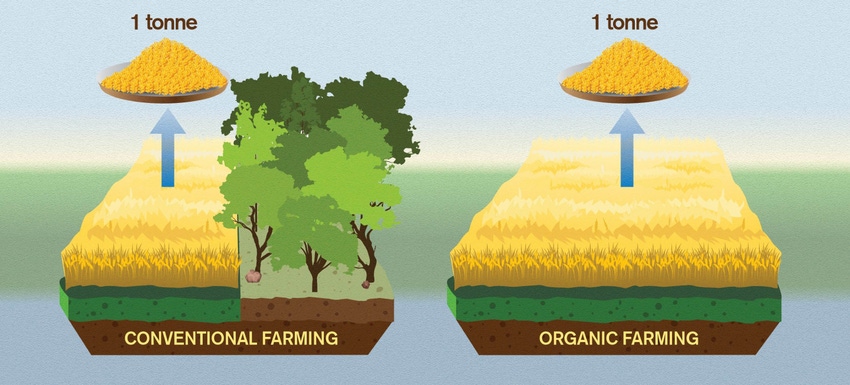New study considers effect of land use on organic farming.
December 18, 2018

Organically farmed food has a larger impact on the climate than conventionally farmed food due to the greater areas of land required, according to a new international study involving Chalmers University of Technology in Sweden that was recently published in the journal Nature.
The researchers developed a new method for assessing the climate impact from land use and used this, along with other methods, to compare organic and conventional food production, Chalmers explained in an announcement. The results show that organic food can result in much greater emissions.
“Our study shows that organic peas, farmed in Sweden, have around a 50% bigger climate impact than conventionally farmed peas. For some foodstuffs, there is an even bigger difference: For example, with organic Swedish winter wheat, the difference is closer to 70%,” said Stefan Wirsenius, an associate professor from Chalmers and a participant on the study.
The reason why organic food is so much worse for the climate is that the yields per hectare are much lower, primarily because fertilizers are not used. To produce the same amount of organic food, a much bigger area of land is required, the university said.
The groundbreaking aspect of the new study is the conclusion that this difference in land usage results in organic food causing a much larger climate impact.
“The greater land use in organic farming leads indirectly to higher carbon dioxide emissions, thanks to deforestation,” Wirsenius explained. “The world’s food production is governed by international trade, so how we farm in Sweden influences deforestation in the tropics. If we use more land for the same amount of food, we contribute indirectly to bigger deforestation elsewhere in the world.”
Even organic meat and dairy products are — from a climate point of view — worse than their conventionally produced equivalents, Wirsenius said.
“Because organic meat and milk production uses organic feeds, it also requires more land than conventional production. This means that the findings on organic wheat and peas in principle also apply to meat and milk products. We have not done any specific calculations on meat and milk, however, and have no concrete examples of this in the article,” he explained.
Carbon opportunity cost
The researchers used a new metric, which they call “carbon opportunity cost,” to evaluate the effect of greater land use contributing to higher carbon dioxide emissions from deforestation, Chalmers said. This metric takes into account the amount of carbon that is stored in forests and, thus, released as carbon dioxide as an effect of deforestation. The study is among the first in the world to make use of this metric.
“The fact that more land use leads to greater climate impact has not often been taken into account in earlier comparisons between organic and conventional food,” Wirsenius said. “This is a big oversight, because, as our study shows, this effect can be many times bigger than the greenhouse gas effects, which are normally included. It is also serious because today in Sweden, we have political goals to increase production of organic food. If those goals are implemented, the climate influence from Swedish food production will probably increase a lot.”
So, why have earlier studies not considered land use and its relationship to carbon dioxide emissions?
“There are surely many reasons. An important explanation, I think, is simply an earlier lack of good, easily applicable methods for measuring the effect. Our new method of measurement allows us to make broad environmental comparisons with relative ease,” Wirsenius said.
The results of the study were published in the article “Assessing the Efficiency of Changes in Land Use for Mitigating Climate Change” in Nature. The article was written by Timothy Searchinger at Princeton University in the U.S., Wirsenius, Tim Beringer at Humboldt Universitätzu Berlin in Germany and Patrice Dumas at CIRED in France.
Wirsenius noted that the findings do not mean that conscientious consumers should simply switch to buying non-organic food.
“The type of food is often much more important. For example, eating organic beans or organic chicken is much better for the climate than to eat conventionally produced beef,” he said. “Organic food does have several advantages compared with food produced by conventional methods. For example, it is better for farm animal welfare, but when it comes to the climate impact, our study shows that organic food is a much worse alternative, in general.”
For consumers who want to contribute to the positive aspects of organic food production without increasing their climate impact, an effective way is to focus instead on the different impacts of different types of meat and vegetables in the diet. Replacing beef and lamb as well as hard cheeses with vegetable proteins such as beans has the biggest effect. Pork, chicken, fish and eggs also have a substantially lower climate impact than beef and lamb, Wirsenius said.
You May Also Like

.png?width=300&auto=webp&quality=80&disable=upscale)

